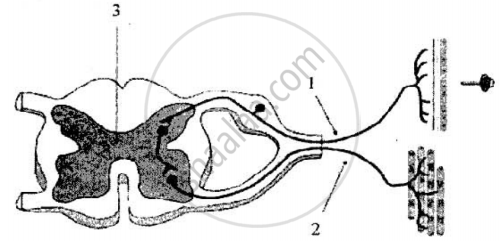Advertisements
Advertisements
प्रश्न
Write down the following activities in the correct order for a simple reflex arc:
(a) impulse travels in the motor fibre
(b) impulse travels in the sensory fibre
(c) effector organ stimulated
(d) impulse crosses the synapse
उत्तर
The pathway taken by nerve impulses in a reflex action is called a reflex arc. It is an automatic response to a stimulus. When a stimulus is given to a receptor, the receptors produce an impulse in the sensory fibre. The sensory fibre carries this message in the form of an electrical stimulus across the synapse. From the synapse, the impulse travels in the motor fibre and stimulates the effector organ to produce the desired response.
The correct order for a simple reflex arc is:
(b) →(d) → (a) → (c).
APPEARS IN
संबंधित प्रश्न
The diagram given below shows the internal structure of a spinal cord depicting a phenomenon. Study the diagram and answer the questions:

1) Name the phenomenon that is depicted in the diagram. Define the phenomenon.
2) Give the technical term for the point of contact between the two nerve cells.
3) Name the parts numbered 1, 2 and 3.
4) How does the arrangement of neurons in the spinal cord differ from that of the brain?
5) Mention two ways by which the spinal cord is protected in our body.
Give three examples of reflex actions.
When you smell a favourite food your mouth begins to water (that is, you secrete saliva). Write down what is the example of the smell of the food?
A cylindrical structure P in our body begins in continuation with medulla and extends downwards. It is enclosed in a bony cage Q and surrounded by membranes R. As many as x pairs of nerves arise from the structure P. The structure P is involved in the reflex actions of our body and conduction of nerve impulses to and from another organ S of our body with which it forms CNS.
(a) Name the structure P.
(b) Name (i) bony cage Q, and (ii) membranes R.
(c) How much is x?
(d) Name the organs S.
(e) What are the reflexes involving structure P only known as?
Define voluntary and reflex actions. Give examples of each.
What is a reflex action?
State whether the following is
Blinking
Which one of the following is not a simple reflex?
How is the mode of action in beating of the heart different from reflex actions? Give four examples.
Categorise the following under stimulus and response.
Seeing a green light turning into red at a road crossing before applying the brakes.
